Tagging Hygiene Is the Foundation of FinOps
Without reliable tags, FinOps becomes guesswork. Finance cannot attribute spend, engineering cannot benchmark efficiency, and leadership cannot make informed trade-offs. Yet tagging hygiene deteriorates quickly as teams move fast. CoreFinOps treats tagging as a managed discipline by combining automation, visibility, and culture-building. The goal is simple: deliver trustworthy cost transparency with minimal manual chasing.
When tags are healthy, dashboards tell the truth, chargebacks are fair, and optimization efforts land where they should. Investing in hygiene is not busywork-it is the multiplier that makes every other FinOps initiative succeed.
Drift Detection Spots Problems Before Reports Break
Tagging drift occurs when required keys vanish, values change unexpectedly, or new resources launch without metadata. CoreFinOps scans AWS accounts continuously for these patterns. When drift appears, the platform pinpoints the resource, owner, and time of impact. Teams receive contextual alerts with remediation options: fix manually, apply an autocorrect, or request an exception if the resource is intentionally exempt.
The system also measures drift severity. A single development instance missing a cost center triggers a gentle nudge, while dozens of production resources missing environment tags prompt immediate escalation. Prioritization keeps teams focused on the issues that threaten financial accuracy the most.
Autocorrect Previews Build Trust in Automation
Automation can repair tags, but teams want transparency before letting scripts touch infrastructure. CoreFinOps introduces autocorrect previews: a dry-run report that shows exactly which tags will change, what values will be applied, and the estimated impact on cost allocation. Stakeholders review the preview, tweak mappings if needed, and approve the fix. Once executed, the platform logs the action and monitors for regression.
Previews reduce anxiety about overreach while still eliminating manual toil. Engineering trusts that automation respects their workloads, and finance sees the pathway to cleaner reports. Over time, organizations graduate from manual fixes to fully automated enforcement with high confidence.
Compliance Metrics That Motivate Teams
Metrics motivate improvement when they are fair and visible. CoreFinOps tracks tagging compliance as a percentage of spend covered by required keys, broken down by team, environment, service, and account. Dashboards highlight top performers and areas needing support. Weekly digests celebrate improvements and call out regressions with actionable tips.
These metrics feed directly into the ROI ledger and chargeback models. Teams that maintain high compliance enjoy faster reimbursement cycles and fewer disputes. Those lagging receive coaching, not punishment, because the data pinpoints specific gaps they can address.
Education Built into Developer Workflows
Tagging hygiene sticks when developers understand the why and the how. CoreFinOps embeds micro-learning modules into onboarding, IDE extensions, and pull request templates. Developers see tagging checklists alongside deployment scripts, and CI pipelines flag missing metadata before code hits production. The platform offers quick-reference guides sorted by service-EC2, Lambda, ECS-so teams know the expected keys and naming conventions.
Leaders can assign playbooks tailored to their teams, ensuring standards stay current with evolving architecture. Education becomes a continuous drip, not a one-time training session.
Integrating Tagging with Governance and Chargeback
Tag compliance does more than inform reports; it drives governance. CoreFinOps guardrails can enforce policies based on tags, such as shutting down non-prod instances outside business hours or routing anomalies to the correct team. Chargeback models rely on tags to allocate spend accurately. By keeping tags healthy, organizations enable automation, accountability, and financial fairness.
When finance trusts tagging data, billing disputes plummet. Business units see precisely what they consume, and strategy conversations shift from debating numbers to planning efficiency investments.
Sustaining Hygiene with Continuous Improvement
Tagging discipline is not a one-time project. CoreFinOps supports continuous improvement by comparing weekly compliance trends, highlighting new services lacking coverage, and suggesting policy refinements. When a team introduces a new product, the platform recommends additional tags to capture revenue attribution. When AWS launches new features, CoreFinOps updates best practices and offers guided rollouts.
This ongoing partnership ensures tagging hygiene stays resilient as the cloud evolves. Teams can move fast, confident that transparency will keep up with their innovation.
Wrapping up
Clean tagging is the backbone of transparent cloud finance. With CoreFinOps handling drift detection, autocorrect previews, and compliance tracking, teams spend less time policing metadata and more time optimizing value.
When every dollar is attributed accurately, FinOps conversations gain credibility, stakeholders collaborate smoothly, and cost savings flow to the initiatives that matter most.
